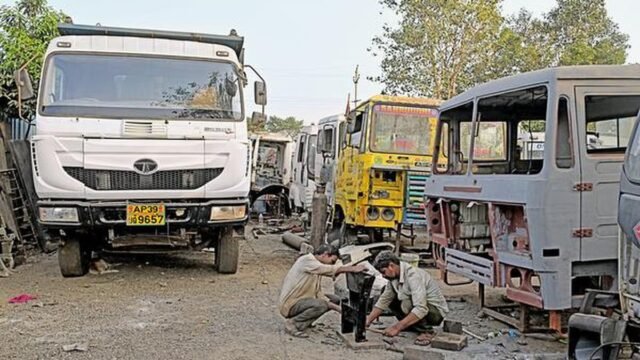Auto Nagar, one of the largest automotive hubs in the country, is akin to an engine running in full throttle. On its main road swarm innumerable people and vehicles, and in its air lingers the odour of diesel and old grease.
When, however, one enters the dusty and wide lane of the 4th Cross Road, once home for scores of lorry-body building workshops and lined on either side by old-fashioned lorries renowned for their fabulous paint works, the din slowly dies.
Except for the occasional clanging of metal tools and the whirring of motors, the road remains silent. Many of its signature workshops (or sheds in local parlance) have put up the shutters, for good. The feverish activity so characteristic of Auto Nagar is starkly missing here.
Sheik Kaza, who supervises works relating to painting of lorries at Sheik Muneer Body-Building Workshop, sits inside a small office, wearing a clean sky-blue kurta. He was free to talk for a long time, which, he says, was unusual at this time of the year. Earlier, there were 25 people working under him; now, there are three, he says with a smile, which, however, failed to mask his fears of unemployment.
Most of the interior streets, where hundreds of lorry-body building workshops are located, wear a similar, forlorn look, with men having nothing much to do, despite January being the season for their business. Dust seemed to be the most active detail in the locality, covering everything and everyone.
The reasons for this reversal of fortunes are various, Mr. Sheik Kaza begins. The first has to do with a policy decision by the Centre, the second is the falling number of youth coming for work and the third is the decisions of the State government over the past five years, which put lorry owners in a fix.
The first domino
In February 2016, the Ministry of Road Transport and Highways released a draft notification on Bharat Stage (BS) VI standards for all on-road vehicles, and the new norms came into effect on April 1, 2020. Though the transition was aimed at laying a foundation for a greener future by reducing emissions from vehicles, its impact was severe on lorry-body building units in the unorganised sector.
The cabins, engines and other parts of BS VI-compliant vehicles are technologically much advanced than those in earlier standards. And these advancements are beyond the understanding of most of the illiterate but skilled workers of Auto Nagar, which survives on lorry cabin and body construction and vehicles repair.
“Auto Nagar used to have 10,000 independent lorry-body building workshops. The number has now shrunk to fewer than 5,000; thousands lost their jobs,” says Mr. Sheik Kaza.
Elaborating on their work, Mr. Sheik Kaza says that lorry manufacturers such as Bharat Benz, Tata Motors and Ashok
Leyland used to sell only chassis and cowl of a lorry. It was the independent lorry-body building workshops, like those in Auto Nagar, that built the cabin and the cargo body of the vehicle, depending on the type of goods it would be expected to carry. Thousands of families depended on lorry-body building industry in Auto Nagar, he says.
Explaining why the new emission norms turned out to be a bane for local workers, Industrial Area Local Authority chairperson Durga Prasad says: “The BS VI model requires sophisticated cabins. They have sensors, and one needs a laptop to repair BS VI-compliant vehicles. Our workers here can work on BS II and III-compliant vehicles but are not equipped with the knowledge required in fabricating a lorry cabin in compliance with BS VI norms.”
Moreover, cabins are now being supplied by the manufacturers themselves, displacing the jobs of thousands of workers skilled in installing cabins.
Livelihood for many
“A lorry cabin is a source of employment to 10-15 people from five different sectors, including electricians, welders, painters and those who do tinkering. Sometimes, they, in turn, hire helpers to fix seats, mirrors, etc. On the other hand, the cargo body is built by blacksmiths. If cabins are supplied by companies, what will we be left with?” asks Mr. Prasad.
Generally, over 5,000 lorries from across the State and also from neighbouring States of Karnataka, Tamil Nadu, Odisha and sometimes from Maharashtra visit Auto Nagar every month. The automotive hub is a source of direct employment to over one lakh workers, including mechanics, blacksmiths, painters, carpenters and welders, and indirect employment to many more such as helpers and tea and snack vendors, Mr. Prasad says. According to Mr. Prasad, around 10,000 workers left for other places, such as Warangal and Khammam in Telangana, in search of jobs in other sectors, immediately after the manufacturers began supplying cabins.
S Chinna Rao, owner of Dhana Lakshmi Body Building Workshop and president of Auto Nagar Body Building Association, says December-April period was a good time for their businesses. “In 2019-2020, we got orders from 80 to 100 lorry owners. Now, the number has shrunk to 20-40,” he says. Mr. Chinna Rao says the body is custom-made depending on the type of goods that the vehicle would be carrying. “If the lorry is meant for transporting perishables, the body is usually made of wood so as to let in the air,” Mr. Chinna Rao says, adding that an iron body is selected for transporting heavy goods.
It takes 20 days to finish the work on a lorry. Once the body building is done, painters get to work. Depending on the type (light commercial vehicle and heavy commercial vehicle) and the material used to build the body, the workshop owner charges anywhere between ₹4 lakh and ₹5.5 lakh for cabin and the body, Mr. Chinna Rao says.
After paying the electricity and other bills, the workshop owner gives a lump sum to the contractor, who takes their cut and gives the remaining to sub-contractors of painting, tinkering and welding, who, in turn, take their cut. The remaining sum goes to the 20-odd workers, who receive somewhere between ₹900 and ₹1,200 a day.
What lorry owners say
The number of lorry owners bringing their vehicles for fabrication at these workshops has come down after the BS VI model came into effect. Lorry owners, too, are not happy with the model.
Y.V. Eswara Rao, general secretary of A.P. Lorry Owners’ Association, says that after the introduction of BS VI, lorry owners had to go to companies for every small problem. “Repairing a BS VI-compliant vehicle is a costly affair,” he adds.
An increase in green tax on vehicles during the tenure of the previous regime in the State exacerbated the situation, he says. “Earlier, we used to pay somewhere between ₹200 and ₹500 annually. Then, the previous government, through the A.P. Motor Vehicles Taxation (Amendment) Act in 2021, increased the tax to ₹5,000 for 7-10 year-old vehicles, ₹10,000 for 10-12 year-old vehicles and ₹20,000 for vehicles over 12 years old.”
Mr. Eswara Rao said that many stopped entering the business because of the tax burden and mounting maintenance cost.
Short end of the stick
Even a slight change in transport business has a cascading effect on Auto Nagar, and the most affected are the daily wage workers.
At one of the sheds near Durga Prasad’s workshop, Sheik Kaza Vali, a mestri (supervisor) of painting work, takes a few minutes off from his work on a cabin to say that workers used to get ₹1,000 a day. “Now, many have left to work as autorickshaw drivers, construction labourers or vegetable vendors. The current situation has forced them to work for lower wages,” he adds.
Dusting off his kurta, Mr. Sheikh Kaza Vali wonders if there would be anything left in Auto Nagar in the next five years.
Forty-two-year-old D. Suresh, who began working in Auto Nagar at the age of 10, was among the first to look for better opportunities elsewhere. Mr. Suresh, now a painting mestri, felt the pinch during the pandemic. “For two years, I did not have proper work,” says Mr. Suresh, who has now found work in the same industry in Hyderabad, Telangana. “The business in Telangana is far better now. I know many who came here from Vijayawada,” he says over a phone call.
Coming from a family of lorry painters, Mr. Suresh recalled how, as a boy, he used to commute from his house at One Town to Auto Nagar gate on bus by paying a fare of ₹1. From the gate, he would walk to his workshop, carrying his lunch.
“After 14 years, I rose to the position of a supervisor, and, at one point, there were 20 workers under me. Over the past five years, there was a crippling financial crisis … I did not have enough money left after paying the workers,” he says. Faced with no option, Mr. Suresh left for Hyderabad, leaving his family in Vijayawada. The looming danger of unemployment continues to hover over their future, he adds.
The workers had reached out to politicians and officials for help. “We have been told that we would be trained in skills required by a company. But, many of us are not literate. We cannot write down quotations, too. How can we survive in a field where laptops are used for everything? Technology upgrade is good, but governments should also think about small-scale workers like us,” Mr. Suresh says.
“They say robots will paint lorries in future. We are still in the stage where we use terms like ‘gajalu’ for measurements while companies use ‘mm’,” says Mr. Sheik Kaza Vali. “We honed our skills through decades of experience. We do not know any other work. Where will we go with no educational background?” he asks.
Many like Mr. Sheik Kaza Vali is pinning their hopes on the construction activity resuming in Amaravati, which, they feel, will offset some of the negative impact of the transition of vehicles to BS VI standards.
Vijayawada’s Jawahar Auto Nagar and Industrial Estate, or simply, Auto Nagar, sprawls over 330 acres in Vijayawada East Assembly constituency and came into existence in 1966.
Published – January 31, 2025 02:12 am IST







